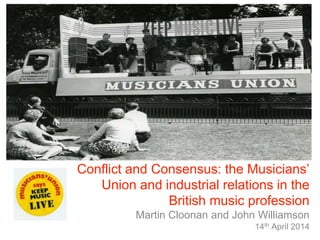Conflict and Consensus: The Musicians' Union and industrial relations in the British music profession
- 1. + Conflict and Consensus: the MusiciansŌĆÖ Union and industrial relations in the British music profession Martin Cloonan and John Williamson 14th April 2014
- 2. Introduction ŌĆó Context ŌĆō project and MU history ŌĆó Industrial relations in the British music profession since 1893: ŌĆó Musical labour and employment ŌĆó How the MU has influenced policy ŌĆó The MU within the trade union movement / musicians as workers
- 3. Our project ŌĆó Funded by the AHRC and ESRC ŌĆō 4 years from 2012-16 ŌĆó Key aims & objectives: ŌĆó ŌĆśfull account of the history of the MU. . .ŌĆÖ ŌĆó ŌĆśways in which the MU has influenced British music and musiciansŌĆÖ ŌĆó ŌĆśan account of the changes in the career of the professional musician in BritainŌĆÖ ŌĆó ŌĆśrole of the MU in influencing public policyŌĆÖ
- 4. A Potted History of the MusiciansŌĆÖ Union ŌĆó Formed by Joseph B. Williams as Amalgamated MusiciansŌĆÖ Union (AMU) in Manchester, 1893. ŌĆó ŌĆ£A protection union . . to protect us from amateurs, unscrupulous employers and ourselves.ŌĆØ ŌĆó 1890s ŌĆō period of growth in musical work and trade unions. ŌĆó Splits between London / elite musicians and rest of country.
- 5. History, contd. ŌĆó Merger with NOUPM (formerly London Orchestral Association) in 1921. ŌĆó Talkies + economic problems ŌĆö> decline & unemployment in 1930s ŌĆó Growth through Voluntary Organising Groups + BBC + recording industry + post War demand for live entertainment. ŌĆó Relatively stable membership - currently 30 446 (2012), slower decline than trade unions generally.
- 6. 120 years of industrial relations in 2 minutes . . ŌĆó When we think of musicians as workers what happens? ŌĆó EMPLOYERS: in 1895 places of work included theatres and music halls; assemblies and dances; balls; lectures and entertainments; bazaars; Garden Parties, Wedding parties; church services + summer seasons at seaside (piers, etc.)
- 7. 120 years of industrial relations in 2 minutes . . ŌĆó Initial negotiations with individual theatre owners, then groups of them, then employersŌĆÖ organisations ŌĆó Growth in number of employers reliant on state funding via BBC, Arts Council, etc. ŌĆó Ever changing locations of employment in private sector: music halls, theatres, cinemas, restaurants and cafes, ballrooms, palais, cruise ships, resorts, ice rinks, etc.
- 8. 120 years of industrial relations in 2 minutes . . ŌĆó musicians often viewed by other workers as ŌĆśdouble jobbersŌĆÖ ŌĆó 3 (fluid / flexible) types of musical employee: permanently employed; self-employed and freelance employees; casually employed musicians. ŌĆó Most fall into self-employed / freelance category. ŌĆó DHA: ŌĆ£only 10% of musicians are full-time salaried employees. . Half of musicians have no regular employment whatsoeverŌĆØ (2012:14)
- 9. MU and policy ŌĆó 3 major areas of policy of concern to the Union: ŌĆóCopyright ŌĆō since 1911; agreement with PPL in 1946; performersŌĆÖ rights; copyright terms extension on sound recordings. ŌĆóBroadcasting ŌĆō since 1922 ŌĆō 3 phases: BBC monopoly; advent of independent television (1955) and radio (1973); lightly regulated market since MMC report (1989) and Broadcasting Act (1990) ŌĆóEmployment - live performance ŌĆō police / military bands /jazz ŌĆ£banŌĆØ / protecting jobs for British workers / subsidy: Music Promotion Committee
- 10. MusiciansŌĆÖ Union / methods ŌĆó How have they gone about influencing policy - (i) on their own and (ii) with other Unions or employers. ŌĆó On their own: collective bargaining / threat of strike action ŌĆō but only de facto closed shop in orchestras and few strikes, so negotiation and threat of strike action ŌĆó Long and short term alliances: with other trade unions nationally and internationally / with employers where interests align (e.g. copyright?) or government pressure (UK Music)
- 11. Conclusions ŌĆó 3 major contributions made by the MU since its formation: ŌĆópay and conditions: rates (in some cases) remain high and over provision of orchestras remains ŌĆóperformersŌĆÖ rights: lengthy campaign- finally recognised in Rome Convention and British copyright law in 1996. ŌĆópatron of musical events: support for orchestras, jazz through Music Promotion Committee
- 12. Conclusions ŌĆó Context of changes in music / cultural industries since 1979 as well as changes in employment law. ŌĆó 1980s Union legislation + MMC Collective Licensing report(1988) + Broadcasting Act (1990) ended most restrictive practices set up by Union ŌĆó MU a forerunner of ŌĆśnew unionismŌĆÖ- already worked with employers and extensive range of services provided.
- 13. Conclusions ŌĆóPeripatetic nature of workforce + non-essential nature of the work + ŌĆśentrepreneurialŌĆÖ tendencies of members result in ŌĆóPragmatic rather than dogmatic leaders willing to engage with employers and (on occasion) privilege needs of individual members over notions of collectivism
- 14. Contact Us. . . Thanks for listening. Please have a look at the website. (www.muhistory.com ) Feel free to get in touch . . . John Williamson: John.C.Williamson@glasgow.ac.uk Martin Cloonan: Martin.Cloonan@glasgow.ac.uk














